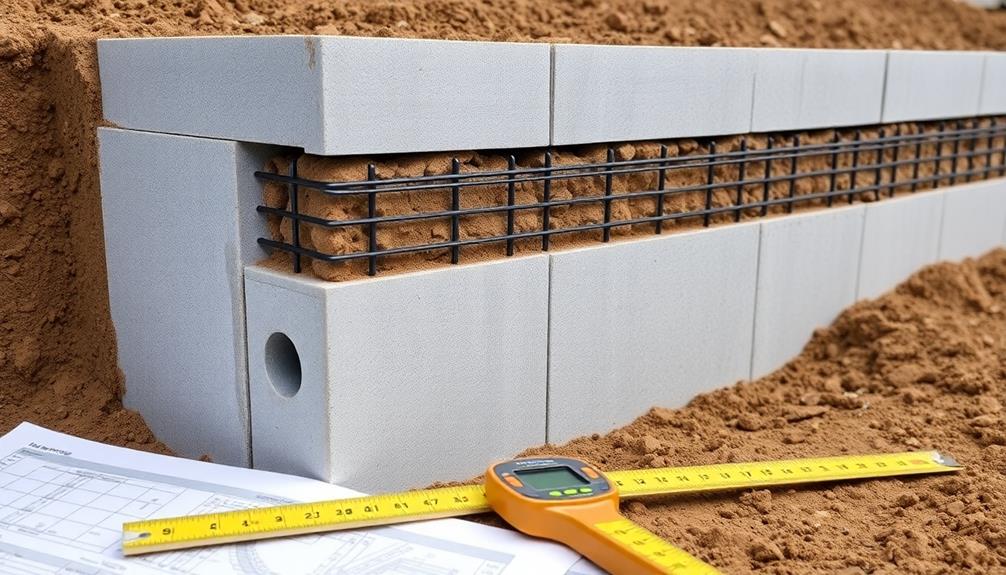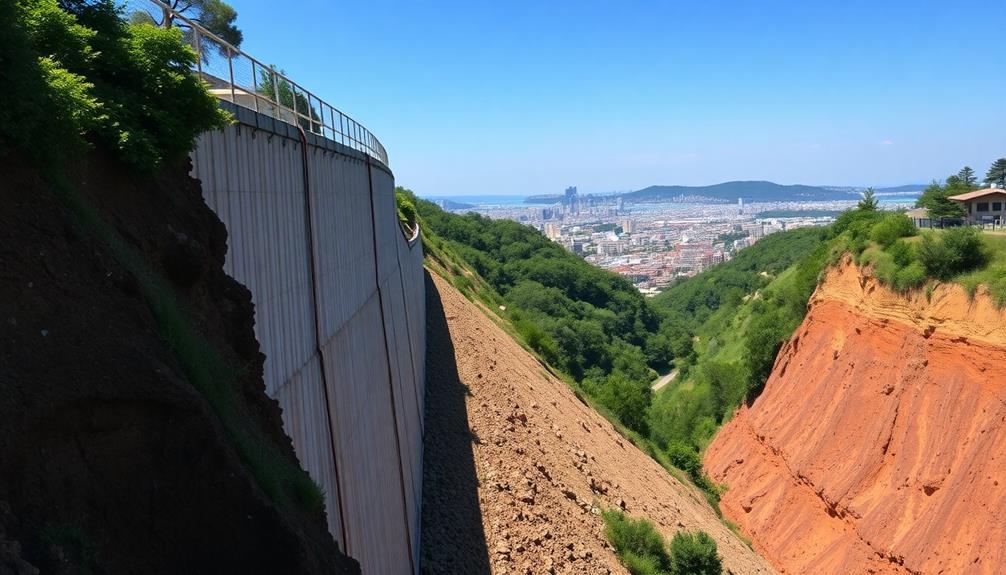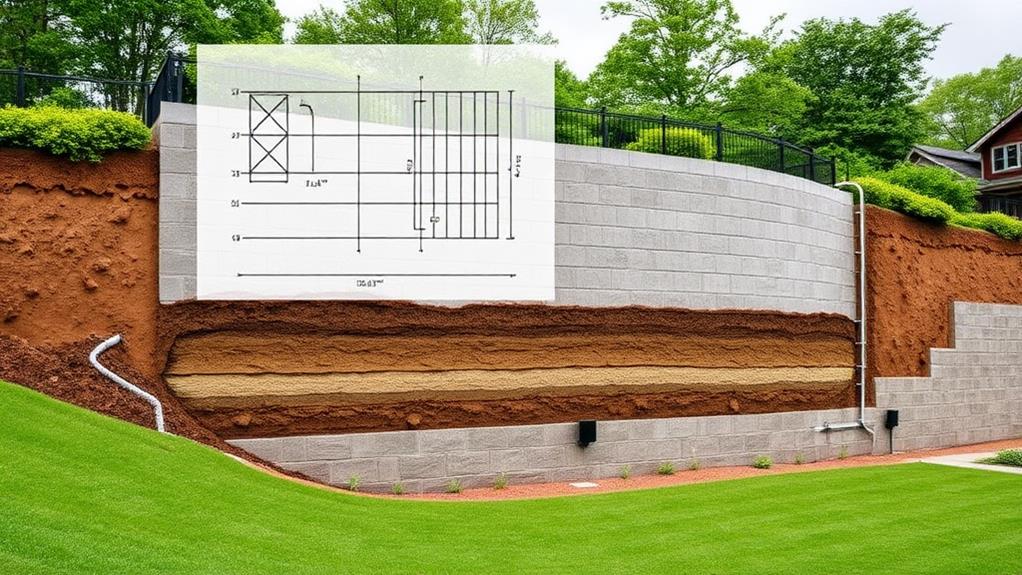Regulations in retaining wall design are paramount for ensuring structural integrity, public safety, and environmental protection. These guidelines mandate rigorous load-bearing capacity calculations, material strength standards, and soil pressure considerations, which collectively safeguard against catastrophic failures and associated liabilities. By standardizing practices, regulations promote consistency across projects, streamline approval processes, and facilitate professional training. Moreover, they necessitate extensive soil testing, including composition analysis, load-bearing capacity tests, and drainage assessments, which inform vital design decisions. Adherence to these regulations not only guarantees the longevity and durability of structures but also mitigates environmental impacts and fosters legal compliance. A deeper exploration of these standards reveals their far-reaching implications for construction projects.
Table of Contents
ToggleWalls Contractor Highlights
- Regulations ensure safety by mandating proper load-bearing capacity calculations and material strength standards.
- They promote environmental impact mitigation through sustainable practices and erosion control measures.
- Regulations provide legal compliance assurance, minimizing liability and streamlining approval processes.
- They standardize practices across projects, guaranteeing consistent safety and performance criteria.
- Regulations require thorough soil testing, ensuring appropriate design for specific site conditions and soil properties.
Structural Integrity Requirements for Walls

Structural integrity requirements for retaining walls encompass critical factors that guarantee the wall's ability to withstand various forces and pressures over time. These requirements include precise load-bearing capacity calculations, which determine the wall's ability to support both static and dynamic loads, as well as adherence to material strength standards that specify the minimum compressive and tensile strengths for construction materials.
Boulder retaining walls are particularly durable and long-lasting, making them an excellent choice for projects requiring exceptional structural integrity. Proper design and construction techniques are essential to maximize their strength and stability.
Additionally, soil pressure considerations play a crucial role in wall design, as they account for the lateral earth pressures exerted on the wall and influence factors such as wall thickness, reinforcement, and drainage systems.
Load-Bearing Capacity Calculations
Three critical factors determine the load-bearing capacity calculations for retaining walls: soil pressure, surcharge loads, and hydrostatic forces. These calculations are essential for ensuring the structural integrity and longevity of retaining walls, which play a pivotal role in our built environment.
Engineers must meticulously consider various factors, including soil composition, groundwater levels, and potential external loads, to accurately determine the wall's required strength and stability.
Soil pressure analysis involves evaluating lateral earth pressures and their distribution along the wall's height. Surcharge load calculations account for additional forces from nearby structures, vehicles, or equipment. Hydrostatic force evaluation considers the impact of water pressure on the wall's stability.
Material Strength Standards
When designing retaining walls, engineers must adhere to stringent material strength standards to guarantee structural integrity and safety. These standards encompass a detailed set of requirements for various construction materials, including concrete, steel, masonry, and timber. Each material must meet specific compressive, tensile, and shear strength criteria to withstand the immense lateral earth pressures and potential surcharge loads exerted on the wall.
For concrete retaining walls, the specified compressive strength typically ranges from 3,000 to 5,000 psi, depending on the wall's height and soil conditions. Steel reinforcement must conform to ASTM A615 or A706 standards, ensuring proper yield strength and ductility.
Masonry units and mortar are subject to ASTM C90 and C270 specifications, respectively, guaranteeing consistent quality and performance. Timber retaining walls require pressure-treated lumber that meets AWPA standards for decay resistance and structural integrity.
Engineers must also consider factors such as durability, corrosion resistance, and long-term performance when selecting materials. By meticulously adhering to these material strength standards, designers ensure that retaining walls will effectively resist loads, maintain stability, and provide reliable service throughout their intended lifespan, safeguarding both property and public safety.
Soil Pressure Considerations
While material strength standards form the foundation of retaining wall design, engineers must also carefully evaluate soil pressure considerations to guarantee structural integrity. The complex interplay between soil characteristics, groundwater conditions, and external loads substantially impacts the wall's performance and longevity.
Geotechnical engineers meticulously analyze these factors to determine the appropriate design parameters, ensuring the wall can withstand both active and passive earth pressures.
Key considerations in soil pressure analysis include:
- Soil type and composition
- Water table fluctuations and drainage patterns
- Surcharge loads from nearby structures or traffic
Benefits

Retaining wall design regulations offer numerous advantages that extend beyond mere structural stability. These regulations guarantee safety and structural integrity, mitigate environmental impacts, and provide legal compliance assurance for builders and property owners.
Boulder retaining walls offer a natural and long-lasting solution that can boost curbside charm while serving both functional and visual purposes. Additionally, they facilitate the standardization of practices across the industry, promoting consistency and reliability in retaining wall construction and maintenance.
Safety and Structural Integrity
Three key benefits of adhering to safety and structural integrity regulations in retaining wall design stand out. These regulations guarantee that retaining walls are constructed to withstand various environmental stresses, protecting both property and lives. By following established guidelines, engineers and contractors can minimize the risk of catastrophic failures, which could result in significant damage and potential legal liabilities.
Increased longevity and durability of structures
Enhanced protection against soil erosion and water damage
Reduced maintenance costs over the lifespan of the wall
Adhering to these regulations fosters a sense of community responsibility, as properly designed retaining walls contribute to the overall safety and aesthetics of neighborhoods. The implementation of standardized design practices allows for consistent quality across different projects, ensuring that all members of the community benefit from reliable infrastructure.
In addition, compliance with safety and structural integrity regulations demonstrates a commitment to professional excellence, instilling confidence in clients and stakeholders. This adherence also facilitates smoother approval processes with local authorities, expediting project timelines and reducing potential delays. Ultimately, these regulations serve as a cornerstone for creating resilient and sustainable built environments that enhance the quality of life for all residents.
Environmental Impact Mitigation
Beyond safety considerations, retaining wall design regulations also address environmental impact mitigation, offering numerous benefits for both ecosystems and communities. These regulations often mandate the incorporation of sustainable materials and practices, minimizing the ecological footprint of construction projects. By requiring proper drainage systems and erosion control measures, these standards help preserve soil stability and protect nearby water sources from contamination. Additionally, regulations may necessitate the integration of native plant species into retaining wall designs, promoting biodiversity and habitat restoration.
Furthermore, environmental impact mitigation regulations encourage innovative solutions that blend retaining walls seamlessly into the natural landscape. This approach not only enhances aesthetic appeal but also reduces the visual impact on surrounding areas. By implementing guidelines for permeable surfaces and rainwater harvesting, these regulations contribute to improved stormwater management and groundwater recharge. In addition, they often stipulate the use of recycled or locally sourced materials, reducing carbon emissions associated with transportation and manufacturing. Ultimately, these environmental considerations in retaining wall design regulations foster a sense of stewardship among community members, ensuring that infrastructure development aligns with sustainable practices and long-term ecological health.
Legal Compliance Assurance
With legal compliance assurance, retaining wall design regulations offer numerous benefits to stakeholders involved in construction projects. These regulations establish a framework that guarantees all parties adhere to standardized practices, mitigating risks associated with non-compliance.
By following these guidelines, designers, contractors, and property owners can confidently navigate the complex landscape of construction law, reducing the likelihood of costly legal disputes and potential safety hazards.
- Minimizes liability exposure for all parties involved
- Streamlines the approval process with local authorities
- Ensures consistency in design and construction practices across projects
Legal compliance assurance also fosters a sense of community responsibility among industry professionals. By adhering to established regulations, we collectively contribute to the creation of safer, more resilient infrastructure that benefits society as a whole.
This shared commitment to excellence not only enhances the reputation of the construction industry but also instills confidence in clients and the general public. Moreover, compliance with retaining wall design regulations demonstrates a proactive approach to risk management, potentially leading to more favorable insurance terms and reduced premiums for construction firms.
Ultimately, legal compliance assurance serves as a cornerstone for sustainable, responsible development practices in the built environment.
Standardization of Practices
Standardization of practices in retaining wall design regulations offers a multitude of benefits to the construction industry and its stakeholders. By establishing uniform guidelines and procedures, these regulations create a cohesive framework that promotes consistency and reliability across projects. This standardization guarantees that all retaining walls, regardless of location or builder, meet the same stringent safety and performance criteria, thereby reducing the risk of structural failures and associated liabilities.
Furthermore, standardized practices streamline the design and approval processes, leading to increased efficiency and cost-effectiveness. Engineers, contractors, and regulatory bodies can work within a well-defined set of parameters, facilitating smoother collaboration and expediting project timelines. This uniformity also simplifies the training of professionals and the education of future engineers, as core principles and methodologies remain consistent across the industry.
Additionally, standardization fosters innovation by providing a stable foundation upon which new technologies and techniques can be developed and integrated. As a result, the construction community benefits from a shared language of best practices, enabling continuous improvement and advancement in retaining wall design and implementation.
Soil Testing Guidelines

Soil testing guidelines form a critical foundation for safe and effective retaining wall design. These guidelines encompass several key components, including soil composition analysis, load-bearing capacity tests, and site-specific drainage assessments. The following table outlines the primary objectives and methodologies associated with each of these essential soil testing elements:
| Testing Component | Objectives | Methodologies |
|---|---|---|
| Soil Composition Analysis | Determine soil type and properties | Sieve analysis, hydrometer tests |
| Load-Bearing Capacity Tests | Assess soil strength and stability | Plate load test, penetration tests |
| Drainage Assessment | Evaluate water flow and retention | Percolation tests, hydraulic conductivity measurements |
| Geotechnical Investigation | Identify subsurface conditions | Borehole drilling, soil sampling |
Soil Composition Analysis
Underpinning the success of any retaining wall project, a critical soil composition analysis is indispensable for determining the appropriate design and construction methods. This essential process involves a thorough evaluation of the soil's physical and chemical properties, providing engineers with necessary data to safeguard the wall's stability and longevity.
By examining factors such as particle size distribution, moisture content, and organic matter concentration, professionals can accurately assess the soil's bearing capacity and potential for settlement.
- Grain size analysis to determine soil texture and drainage characteristics
- Atterberg limits testing to evaluate soil plasticity and shrink-swell potential
- Chemical composition assessment to identify corrosive elements or contaminants
The results of these analyses guide engineers in selecting suitable materials and construction techniques, tailored to the specific site conditions. For instance, soils with high clay content may require additional drainage measures to prevent hydrostatic pressure buildup, while sandy soils might necessitate deeper foundations to achieve adequate stability.
Load-Bearing Capacity Tests
To guarantee the structural integrity of retaining walls, engineers must conduct thorough load-bearing capacity tests as part of their soil testing regimen. These tests are pivotal for determining the soil's ability to support the weight of the proposed structure and resist lateral earth pressures. Geotechnical engineers employ various methodologies, including plate load tests, standard penetration tests (SPT), and cone penetration tests (CPT), to assess the soil's bearing capacity accurately.
The data collected from these tests enables designers to calculate the maximum allowable bearing pressure and estimate potential settlement. This information is essential for selecting appropriate foundation types and dimensions, as well as determining the necessary reinforcement for the retaining wall. By adhering to rigorous testing protocols, engineers can mitigate risks associated with soil failure, which could lead to wall collapse or excessive deformation.
Moreover, these tests help verify compliance with local building codes and industry standards, providing assurance to property owners and regulatory bodies alike. Ultimately, comprehensive load-bearing capacity testing forms the cornerstone of safe and reliable retaining wall design, safeguarding both public safety and infrastructure longevity.
Site-Specific Drainage Assessment
Consistently, a site-specific drainage assessment forms a critical component of soil testing guidelines for retaining wall design. This expansive evaluation examines the unique hydrological characteristics of the proposed construction site, guaranteeing that the retaining wall can effectively manage water flow and pressure.
By conducting a thorough analysis of soil permeability, groundwater levels, and surface runoff patterns, engineers can develop tailored drainage solutions that mitigate potential risks associated with water accumulation and soil saturation.
Key aspects of a site-specific drainage assessment include:
- Soil infiltration rate testing to determine water absorption capacity
- Groundwater table monitoring to assess subsurface hydrology
- Topographical analysis to identify natural drainage patterns and potential problem areas
The data collected during this assessment enables designers to incorporate appropriate drainage systems, such as weep holes, French drains, or geotextile fabrics, into the retaining wall structure. These features work in concert to alleviate hydrostatic pressure, prevent soil erosion, and maintain the wall's structural integrity over time.
Walls Contractor FAQ
How Often Should Retaining Walls Be Inspected After Construction?
Retaining walls should be inspected annually, with more frequent checks after severe weather events. This guarantees our community's safety and preserves the wall's integrity. Regular inspections help us identify potential issues early, maintaining the structure's longevity and effectiveness.
What Are the Legal Implications of Non-Compliance With Retaining Wall Regulations?
Non-compliance with retaining wall regulations can lead to serious legal consequences for property owners and contractors. These may include fines, liability for damages, mandatory reconstruction, and potential lawsuits. Adhering to regulations guarantees safety and protects our community's interests.
Are There Different Regulations for Residential Versus Commercial Retaining Walls?
Yes, regulations often differ for residential and commercial retaining walls. Commercial projects typically face stricter requirements due to higher public use and safety concerns. However, both types must adhere to local building codes and safety standards.
Can Existing Retaining Walls Be Retrofitted to Meet New Regulatory Standards?
Yes, existing retaining walls can often be retrofitted to meet new regulatory standards. This process may involve adding reinforcement, improving drainage, or enhancing structural elements. It is crucial to consult with a professional engineer to guarantee compliance and safety.
How Do Climate and Weather Patterns Influence Retaining Wall Regulations?
Climate and weather patterns considerably impact retaining wall regulations. Factors like rainfall intensity, freeze-thaw cycles, and extreme temperatures are considered when setting standards for drainage, material selection, and structural integrity to guarantee long-term safety and performance for our communities.







